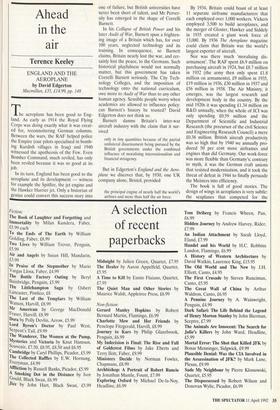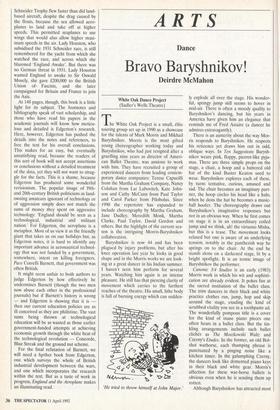Ahead in the air
Terence Keeley
ENGLAND AND THE AEROPLANE by David Edgerton Macmillan, £35, £14.99, pp. 148 he aeroplane has been good to Eng- land. As early as 1914 the Royal Flying Corps was doing exactly what it was creat- ed for, reconnoitering German columns. Between the wars, the RAF helped police the Empire (our pilots specialised in bomb- ing Kurdish villages in Iraq) and 1940 witnessed the apotheosis of the Few. Even Bomber Command, much reviled, has only been reviled because it was so good at its job.
In its turn, England has been good to the aeroplane and its development - witness for example the Spitfire, the jet engine and the Hawker Harrier jet. Only a historian of genius could convert this success story into one of failure, but British universities have never been short of talent, and Mr Perver- sity has emerged in the shape of Correlli Barnett.
In his Collbpse of British Power and his later Audit of War, Barnett spun a frighten- ing image of a Britain which has, for over 100 years, neglected technology and its training. In consequence, so Barnett claims, Britain nearly lost the war, and cer- tainly lost the peace, to the Germans. Such historical playfulness would not normally matter, but this government has taken Correlli Barnett seriously. The City Tech- nology Colleges, and the imposition of technology onto the national curriculum, owe more to Audit of War than to any other human agency. Sensible people worry when academics are allowed to influence policy: can Barnett's history be trusted? David Edgerton does not think so.
Barnett damns Britain's inter-war aircraft industry with the claim that it sur- vived
only in tiny quantities because of the partial unilateral disarmament being pursued by the British governments under the combined influcnce of moralising internationalism and financial stringency.
But in Edgerton's England and the Aero- plane we discover that, by 1930, one UK company alone, Bristol, provided
the principal engine of nearly half the world's airlines and more than half the air force.
By 1934, Britain could boast of at least 11 separate airframe manufacturers that each employed over 1,000 workers. Vickers employed 3,500 to build aeroplanes, and the merger of Gloster, Hawker and Siddely in 1935 created a giant work force of 13,000. By 1936 The Aeroplane magazine could claim that Britain was the world's largest exporter of aircraft.
Nor was there much 'moralising dis- armament'. The RAF spent £6.9 million on purchasing aircraft in 1924, but £8.7 million in 1932 (the army then only spent £1.8 million on armaments), £9 million in 1935, £19 million in 1936, £30 million in 1937 and £56 million in 1938. The Air Ministry, it emerges, was the largest research and development body in the country. By the mid 1920s it was spending £1.34 million on R&D annually, when the whole of ICI was only spending £0.59 million and the Department of Scientific and Industrial Research (the precursor of the civil Science and Engineering Research Council) a mere £0.38 million. British aircraft productivity was so high that by 1940 we annually pro- duced 50 per cent more airframes and engines than did Germany. Our work-force was more flexible than Germany's; contrary to myth, it was the German craft unions that resisted modernisation, and it took the threat of defeat in 1944 to finally persuade the Meisters into efficiency.
The book is full of good stories. The design of wings in aeroplanes is very subtle: the seaplanes that competed for the Schneider Trophy flew faster than did land- based aircraft, despite the drag caused by the floats, because the sea allowed aero- planes to land and take off at higher speeds. This permitted seaplanes to use wings that would also allow higher maxi- mum speeds in the air. Lady Houston, who subsidised the 1931 Schneider race, is still remembered for the yacht from which she watched the race, and across which she blazoned 'England Awake'. But there was no German threat in 1931. Lady Houston wanted England to awake to Sir Oswald Mosely, she gave £200,000 to the British Union of. Fascists, and she later campaigned for Britain and France to join the Axis.
At 148 pages, though, this book is a little light for its subject. The footnotes and bibliography speak of vast scholarship, and those who have read his papers in the academic journals will know how meticu- lous and detailed is Edgerton's research.
Here, however, Edgerton has pushed the details into the notes and references, to free the text for his overall conclusions.
This makes for an easy, but eventually unsatisfying read, because the readers of this sort of book will not accept assertions or conclusions without a detailed treatment of the data, yet they will not want to strug- gle for the facts. This is a shame, because Edgerton has produced some wonderful revisionism. The popular image of 19th- and 20th-century British politicians as land- owning amateurs ignorant of technology or of aggression simply does not match the sums of money they spent on aggressive technology: 'England should be seen as a technological, industrial and militant nation.' For Edgerton, the aeroplane is a metaphor. Most of us view it as the friendly giant that takes us on our holidays but, as Edgerton notes, it is hard to identify any important advance in aeronautical technol- ogy that was not funded by a government,
somewhere, intent on killing foreigners. Pace Correlli Barnett, that government was often British.
It might seem unfair to both authors to judge Edgerton by how effectively he undermines Barnett (though the two men now abuse each other in the professional journals) but if Barnett's history is wrong
-7- and Edgerton is showing that it is —
then our current education policies are as ill conceived as they are philistine. The vast sums being thrown at technological education will be as wasted as those earlier government-funded attempts at achieving economic growth through the white heat of the technological revolution — Concorde, Blue Streak and the ground nut scheme.
For the final refutation of Barnett, we will need a further book from Edgerton, one which surveys the whole of British industrial development between the wars, and one which incorporates the research
within the text. But as a taste of work in progress, England and the Aeroplane makes an illuminating read.



















































 Previous page
Previous page